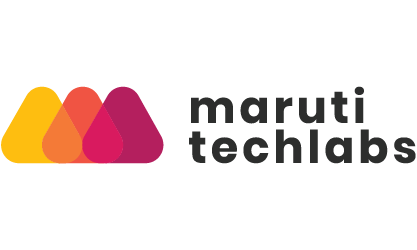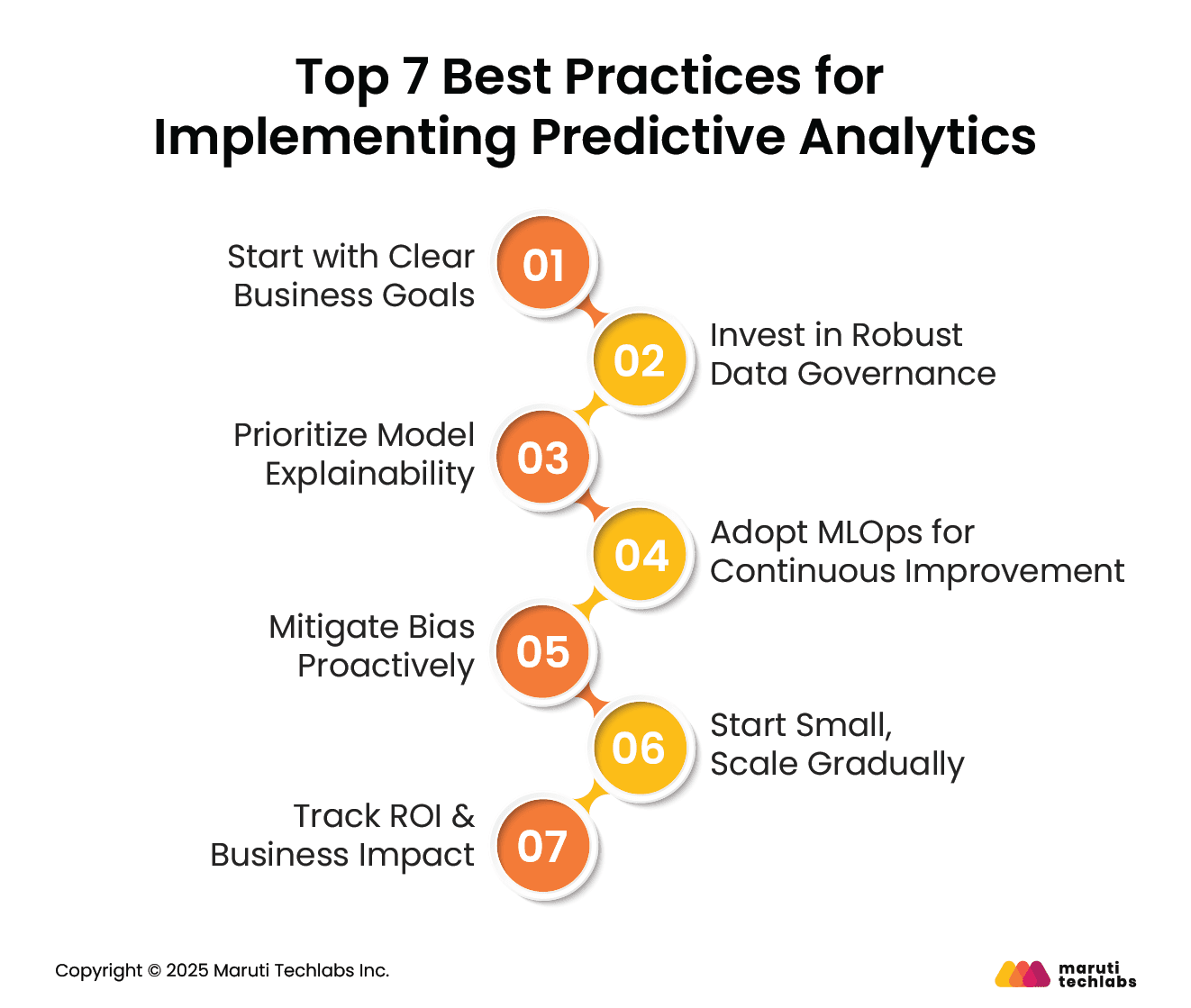17 Predictive Analytics Use Cases Transforming Industries Today
 Maruti Techlabs
Maruti Techlabs
Introduction
Predictive analytics transform operations by using historical and real‑time data to forecast future trends, risks, or behaviors, turning insight into proactive decision‑making.
Organizations leveraging these tools gain a powerful competitive edge: they reduce downtime through predictive maintenance, optimize supply chains by anticipating demand, detect fraud faster, and personalize customer experiences. This predictive foresight helps companies stay agile, efficient, and ahead in fast‑paced markets.
In healthcare, predictive models help identify readmission risks and forecast disease outcomes using EMR data. Legal firms are adopting analytics to predict case outcomes and spot compliance issues. Retail, banking, finance, insurance and manufacturing use prediction to forecast demand, detect fraud, optimize inventory, price products dynamically, and plan maintenance
This article covers 17 real‑world examples of predictive analytics in operations. We’ll also explore emerging trends, challenges and best practices for successful implementation.
Emerging Predictive Analytics Trends to Watch out in 2025
As predictive analytics enters 2025, its evolution is driven by AI-native tools and cloud‑based architectures. Businesses increasingly rely on builtin forecasting models, data‑streaming pipelines, real‑time anomaly detection, and agentic AI to derive proactive insights from growing, complex datasets.
Here are 6 such trends to keep in mind.
1. BigQuery ML
Google’s BigQuery ML now includes the TimesFM model, a pre‑trained transformer for time‑series forecasting that works zero‑shot on unseen data. Combined with ARIMA_PLUS, it lets analysts run scalable, accurate forecasts directly in SQL, no external model training required, simplifying workflows and reducing deployment friction.
2. Cloud‑Native AI Platforms
Cloud‑native AI platforms such as BigQuery, Microsoft Fabric, Snowflake, and Databricks are transforming predictive analytics by providing serverless scalability, integrated machine learning, and automated data pipelines.
They unify data lakes and warehouses, breaking down silos to enable real‑time insights and operational agility. Their native ML capabilities allow organizations to deploy predictive models closer to the data, reducing latency and accelerating decision‑making.
3. Agentic AI and autonomous analytics agents
Agentic AI systems, “AI coworkers”, can plan, execute, and adapt multistep workflows autonomously, surfacing predictions, anomalies, and recommendations in real time to users. These agents transform analytics into proactive operational support, bridging data with execution and reducing manual oversight.
4. Real‑time Streaming
The shift toward continuous data streaming enables predictive analytics to act instantly, identifying anomalies, forecasting trends, and triggering alerts automatically. This capability is pivotal for use cases like fraud prevention, IoT monitoring, and just‑in‑time supply chain decisions.
5. Generative AI and RAG‑Enriched Modeling
Generative AI, including retrieval‑augmented generation (RAG), is enhancing predictive analytics by enabling natural‑language insight generation, automated scenario modeling, and context‑aware forecasts that blend structured data with external knowledge.
6. AI‑Ready Data Warehousing
Platforms combining data lakehouse architecture with built-in AI like Microsoft Fabric, Lakehouse in BigQuery, and Snowflake, support unified storage and predictive model operations. This trend streamlines management, improves data governance, and accelerates insight-to-action scales.
What is Predictive Analytics?
In simple terms, predictive analytics helps to predict future trends and patterns using historical data. It uses different data patterns and identifies the correlations between the variables. It helps to reduce business risks and costs by predicting the future values of certain variables.
For instance, the organization can determine the profits for the coming months by analyzing the output and revenue of the company. The model focuses on two variables; one is dependent while the other is independent.
There are numerous predictive analytics models such as classification models, clustering forecasts, time series, etc. These models help predict future variables based on the insights and data arranged in multiple ways.
Benefits of Predictive Analytics
Here are top 10 key benefits of predictive analytics,
- Improved Decision-Making: Helps organizations make data-driven decisions proactively.
- Risk Management: Identifies potential risks and mitigates them before they escalate.
- Cost Reduction: Optimizes resource allocation, reducing waste and operational costs.
- Enhanced Customer Experience: Anticipates customer needs and personalizes services.
- Increased Efficiency: Automates workflows and prioritizes actions based on predicted outcomes.
- Revenue Growth: Identifies sales opportunities, upselling, and cross-selling prospects.
- Fraud Detection: Recognizes unusual patterns to prevent financial fraud and security breaches.
- Better Inventory Management: Forecasts demand accurately to avoid stockouts or overstock.
- Healthcare Optimization: Predicts patient outcomes, readmissions, and resource needs.
- Competitive Advantage: Enables organizations to stay ahead by anticipating market trends.
How to Implement Predictive Analytics?
Implementing predictive analytics involves a structured process that transforms raw data into actionable insights. Here how you can do this following these 4 essential steps.
1. Data Collection
Gather historical and real-time data from various sources such as databases, sensors, CRM systems, or EHRs. Ensure data quality and completeness.
2. Data Preparation and Modeling
Clean, normalize, and transform the data. Choose appropriate statistical or machine learning models (e.g., regression, decision trees, neural networks) to train and validate predictions.
3. Tool Selection
Use platforms like Python, R, SAS, IBM SPSS, or cloud-based services like AWS SageMaker, Azure ML, or Google Cloud AI for development and deployment.
4. Analysis and Deployment
Interpret the model results to generate forecasts, identify patterns, and support decision-making. Integrate outputs into business workflows or dashboards for real-time action.
Top 7 Best Practices for Implementing Predictive Analytics
- Start with Clear Business Goals: Define use cases that align with organizational objectives to ensure predictive analytics delivers actionable value.
- Invest in Robust Data Governance: Clean, integrated, and accessible data forms the foundation of accurate models.
- Prioritize Model Explainability: Build transparency with XAI to boost stakeholder trust and support ethical decisions.
- Adopt MLOps for Continuous Improvement: Streamline deployment, monitoring, retraining, and performance tracking of predictive models.

- Mitigate Bias Proactively: Use audits and diverse data sets to avoid skewed or discriminatory predictions.
- Start Small, Scale Gradually: Validate models through pilots or proof-of-concept projects before organization-wide rollout.
- Track ROI & Business Impact: Link predictive insights to measurable outcomes, driving stakeholder confidence and ongoing investment.
Top 5 Challenges with Predictive Analytics
Read More:- 17 Predictive Analytics Use Cases
Subscribe to my newsletter
Read articles from Maruti Techlabs directly inside your inbox. Subscribe to the newsletter, and don't miss out.
Written by

Maruti Techlabs
Maruti Techlabs
Maruti Techlabs is an award-winning product strategy, design, and development partner. We bring the strategic value of product development consultants, the technical expertise of product engineers, data and systems architects combined with the UX-first approach to early-stage startups and established ventures. With a rich & varied experience of 13+ years in software development & a global clientele, we do everything from materializing your ideas through rapid application development & improving processes via RPA and AI to streamlining customer support via chatbots. We believe that the best business comes from long-term relationships, and it’s why we strive to build long-term partnerships with our customers. Our team of highly skilled & experienced developers, designers, and engineers understand the market's pulse & specific business needs to provide custom product development solutions. Service Offerings: Product Development Rapid Prototyping Low Code/No Code Development MVP Development Data Engineering Computer Vision Machine Learning Natural Language Processing DevOps Cloud Application Chatbot Development Robotic Process Automation Business Intelligence Data Analytics Quality Engineering Awards & Recognition: Great Place to Work Top B2B IT Company - By Clutch Best Company to Work With - By GoodFirms India’s Growth Champion - Statista & Economic Times Most Reviewed AI Partners - By The Manifest We provide a people-centric work environment that enables our employees to: Enhance their professional & personal growth Use the latest technologies to make a positive impact Experience collaborative innovation with a focus on diversity & work-life balance Discover global opportunities to work & learn with industry leaders Our mission is to help our clients build future-proof and intuitive digital products while guiding them with the best processes & practices that help them undergo a successful digital transformation and scale sustainably.